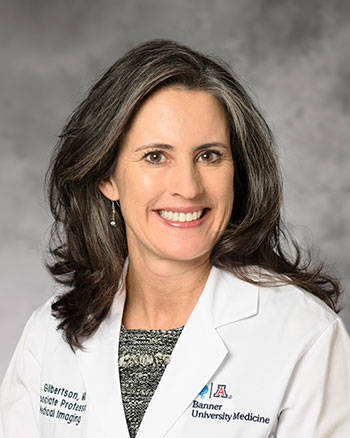By Miguel Craig, MD
Women in Radiology Q&A: Interview With Dorothy Gilbertson-Dahdal, MD
Dorothy Gilbertson-Dahdal, MD, completed her pediatric radiology fellowship training at the Lucile Packard Children's Hospital at Stanford University in Palo Alto, CA. She is board certified by the American Board of Radiology in diagnostic radiology with a certificate of added qualification in pediatric radiology. Dr. Gilbertson-Dahdal has a special interest in congenital cardiac imaging as well as urologic and gastrointestinal MRI. Since completing her fellowship in 2006, she has practiced at the University Medical Center in Tucson, where she currently serves as the Medical Director of Pediatric Radiology at the Diamond Children's Hospital and the Program Director for the Diagnostic Radiology Residency.

What has helped you succeed in a male-dominated field?
Put simply, I show up and work hard every day. There will always be days when it is difficult to find the motivation to be your best. Finding meaning in your work — whether it be to your patients, the parents or your residents — is key to excelling at your job.
What is your advice to trainees?
First, do what you love. Do not choose a subspecialty based on the job market or a possible salary. You should pick the area of radiology that you enjoy the most and focus on that because you want the majority of your time spent doing what you actually enjoy. The job situation will work out. Many of my mentors and prior attendings cautioned me against going into pediatric radiology. However, all those warnings turned out to be false. The job market is cyclic; it will take care of itself.
Second, do not be afraid to take a chance. When I arrived out of fellowship at the University of Arizona, the only other pediatric radiologist was the eminent Paul Capp, MD, FACR. The pediatric section only read plain films and fluoroscopy. We reorganized to take ownership of all non-neuro pediatric cross-sectional imaging including cardiac imaging. It was daunting and a great challenge, but quite successful in the long run.
Third, do not be afraid to call former colleagues, fellows and attendings for advice.
In your opinion, how can radiology improve diversity, equity and inclusion efforts in a sustainable, meaningful way?
Increase upstream exposure. Medical students need to be given the opportunity to experience radiology. A pervasive misconception is that radiologists do not have direct patient care or direct impact on patients. A way to make a lasting change is to show medical students that multiple radiology specialties have direct patient interaction and lasting impact. Pediatric radiology, breast imaging and interventional radiology have copious patient interaction and procedures. You don’t look for what you don’t know, and having exposure to the field of radiology in medical school would surely bring a wider range of applicants.
What are some ways in which trainees can contribute to diversity efforts?
Again, exposing medical students to all the different and interesting aspects of radiology. We do not just sit in a dark room. Directly showing medical students how fun and rewarding radiology can be would help generate interest in the field.
What has been the key to the success of your diversity efforts?
Having women in leadership within our department would show applicants that women can be successful at the University of Arizona. It is difficult to recruit women and minorities given the applicant pool is limited; only 20% of applicants are female. That being said, I make a concerted effort to treat every applicant on an equal basis. I do not want to devalue or demoralize any candidate by telling them they have a spot because they are a minority. I remember being told during my interviews for residency that a program was ranking every female above the male applicants, and I found that insulting. I do not want to be treated differently just to fill a quota; I try to assess everyone on an equal basis.